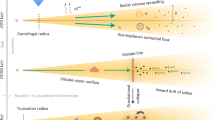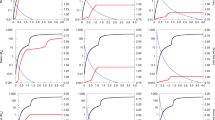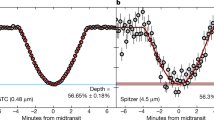Abstract
THE discovery by Voyager I of a thin flat stream of rocks orbiting Jupiter at a radius of some 130,000 km, or ∼2RP (Rp = 6.677 × 109 cm = present polar radius), in its equatorial plane opens a new avenue of information in our understanding of the formation of the Solar System. Each of the major planets which possesses a regular satellite system also possesses a ring system. Theories for the formation of the major planets should therefore address themselves to this phenomenon of the co-appearance of rings and regular satellite systems, especially in considering the question whether Neptune, which has no regular satellites, may also not have a ring. We suggest here that Jupiter's rocky belt formed through condensation from a gaseous disk which was shed by the rotating gaseous envelope that originally contracted to form that planet. The four galilean satellites were formed from gaseous rings which were shed by the same envelope at an earlier and more turbulent stage in its evolution. It is possible that Jupiter may possess another rocky satellite belt at orbital radius 4RP1.
This is a preview of subscription content, access via your institution
Access options
Subscribe to this journal
Receive 51 print issues and online access
$199.00 per year
only $3.90 per issue
Buy this article
- Purchase on Springer Link
- Instant access to full article PDF
Prices may be subject to local taxes which are calculated during checkout
Similar content being viewed by others
References
Prentice, A. J. R. Proc. astr. Soc. Austr. 3, 172–173 (1977).
Prentice, A. J. R. & ter Haar, D. The Moon and the Planets (in the press).
Laplace, P. S. Exposition du Système du Monde, 387–397 (Courcier, Paris, 1796).
Prentice, A. J. R. in In the Beginning (ed. Wild, J. P.) 15–47 (Australian Academy of Science, Canberra, 1974).
Stevenson, D. J. in The Origin of the Solar System (ed. Dermott, S. F.) 395–432 (Wiley, London, 1978).
Babinet, J. C. r. hebd. Séanc. Acad. Sci., Paris 52, 481–484 (1861).
Maxwell, J. C. in The Scientific Papers of James Clerk Maxwell Vol. 1 (ed. Niven, W. D.) 288–376 (Cambridge University Press, 1890).
Prentice, A. J. R. in The Origin of the Solar System (ed. Dermott, S. F.) 111–162 (Wiley, London, 1978).
Prentice, A. J. R. The Moon and the Planets 19, 341–398 (1978).
Prentice, A. J. R. Astr. Astrophys. 27, 237–248 (1973).
Prentice, A. J. R. Astr. Astrophys. 50, 59–70 (1976).
Lewis, J. S. Icarus 16, 241–252 (1972); Earth planet. Sci. Lett. 15, 286–290 (1972).
Hoyle, F. & Wickramasinghe, N. C. Nature 217, 415–418 (1968).
Millis, R. L. Icarus 33, 319–321 (1978).
Graboske, H. C., Pollock, J. B., Grossman, A. S. & Olness, R. J. Astrophys. J. 199, 265–281 (1975).
Toomre, A. Astrophys. J. 139, 1217–1238 (1964).
Goldreich, P. & Ward, W. R. Astrophys. J. 183, 1051–1061 (1973).
Dermott, S. F. & Gold, T. Nature 267, 590–593 (1977).
Author information
Authors and Affiliations
Rights and permissions
About this article
Cite this article
PRENTICE, A., TER HAAR, D. Origin of the jovian ring and the galilean satellites. Nature 280, 300–302 (1979). https://doi.org/10.1038/280300a0
Received:
Accepted:
Issue Date:
DOI: https://doi.org/10.1038/280300a0
This article is cited by
-
Origin and bulk chemical composition of the Galilean satellites and the primitive atmosphere of Jupiter: A pre-Galileo analysis
Earth, Moon, and Planets (1996)
-
Formation of the saturnian system: A modern Laplacian theory
Earth, Moon, and Planets (1984)
-
Discussion of the Pioneer 11 observations of the F ring of Saturn
Nature (1980)
Comments
By submitting a comment you agree to abide by our Terms and Community Guidelines. If you find something abusive or that does not comply with our terms or guidelines please flag it as inappropriate.



